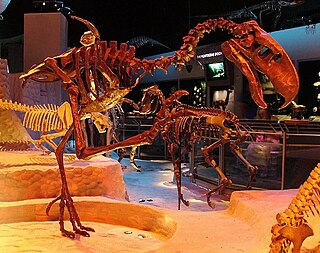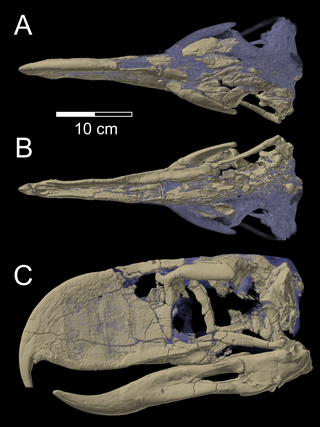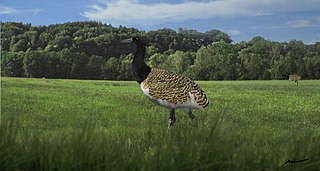
The Gruiformes are an order containing a considerable number of living and extinct bird families, with a widespread geographical diversity. Gruiform means "crane-like".

The seriemas are the sole living members of the small bird family Cariamidae, which is also the only surviving lineage of the order Cariamiformes. Once believed to be related to cranes, they have been placed near the falcons, parrots and passerines, as well as the extinct Phorusrhacidae. The seriemas are large, long-legged territorial birds that range from 70–90 cm (28–35 in) in length. They live in grasslands, savanna, dry woodland and open forests of Brazil, Bolivia, Argentina, Paraguay and Uruguay. There are two species of seriemas, the red-legged seriema and the black-legged seriema. Names for these birds in the Tupian languages are variously spelled as siriema, sariama, and çariama, and mean "crested".

Phorusrhacids, colloquially known as terror birds, are an extinct family of large carnivorous, mostly flightless birds that were among the largest apex predators in South America during the Cenozoic era; their conventionally accepted temporal range covers from 53 to 0.1 million years (Ma) ago, and perhaps even up to 21,600 ± 1,000 years ago.

Plotopteridae is an extinct family of flightless seabirds with uncertain placement, generally considered as member of order Suliformes. They exhibited remarkable convergent evolution with the penguins, particularly with the now extinct giant penguins. That they lived in the North Pacific, the other side of the world from the penguins, has led to them being described at times as the Northern Hemisphere's penguins, though they were not closely related. More recent studies have shown, however, that the shoulder-girdle, forelimb and sternum of plotopterids differ significantly from those of penguins, so comparisons in terms of function may not be entirely accurate. Plotopterids are regarded as closely related to Anhingidae (darters) and Phalacrocoracidae (cormorants). On the other hand, there is a theory that this group may have a common ancestor with penguins due to the similarity of forelimb and brain morphology. However, the endocast morphology of stem group Sphenisciformes differs from both Plotopteridae and modern penguins.

Andalgalornis is a genus of flightless predatory birds of the extinct family Phorusrhacidae that lived in Argentina. The type and only species is A. steulleti.

Strigogyps is an extinct genus of prehistoric bird from the Middle Eocene to Early Oligocene of France and Germany. It was probably around the size of a large chicken or a guan, weighing not quite 1 kilogram (2.2 lb). Apparently, as indicated by the ratio of lengths of wing to leg bones, S. sapea was flightless. Its legs were not adapted to running, so it seems to have had a walking lifestyle similar to trumpeters. Unlike other Cariamiformes, which appear to have been mostly carnivorous, Strigogyps specimens suggest a herbivorous diet.

The Sophiornithidae are an extinct family of chicken-sized predatory birds that lived from the Paleocene to the Eocene periods of the Cenozoic, and were found primarily in Europe, and are thought to be primitive owls.

Palaeotis is a genus of paleognath birds from the middle Eocene epoch of central Europe. One species is known, Palaeotis weigelti. The holotype specimen is a fossil tarsometatarsus and phalanx. Lambrect (1928) described it as an extinct bustard, and gave it its consequent name. After a suggestion by Storrs L. Olson, a review of the type specimen and the referral of several other fossils by Houde and Haubold (1987) concluded that Palaeotis is a palaeognath and assigned it to the same order as ostriches; the Struthioniformes. In 2021, it was considered a member of the family Paleotididae alongside Galligeranoides from the Early Eocene of France, which were found to be basal members of the Struthioniformes.
Paleontology or palaeontology is the study of prehistoric life forms on Earth through the examination of plant and animal fossils. This includes the study of body fossils, tracks (ichnites), burrows, cast-off parts, fossilised feces (coprolites), palynomorphs and chemical residues. Because humans have encountered fossils for millennia, paleontology has a long history both before and after becoming formalized as a science. This article records significant discoveries and events related to paleontology that occurred or were published in the year 1987.
Paleontology or palaeontology is the study of prehistoric life forms on Earth through the examination of plant and animal fossils. This includes the study of body fossils, tracks (ichnites), burrows, cast-off parts, fossilised feces (coprolites), palynomorphs and chemical residues. Because humans have encountered fossils for millennia, paleontology has a long history both before and after becoming formalized as a science. This article records significant discoveries and events related to paleontology that occurred or were published in the year 1976.

Devincenzia is an extinct genus of giant flightless predatory birds in the family Phorusrhacidae or "terror birds" that lived during the Early Miocene (Deseadan) Fray Bentos Formation of Uruguay, Late Miocene (Huayquerian) Ituzaingó Formation, Early Pliocene (Montehermosan) of Argentina, and possibly the Early Pleistocene Raigón Formation of Uruguay. The type species D. pozzi was formerly known as Onactornis pozzi. The largest possible specimen weighed up to 350 kilograms (770 lb), making it one of the largest phorusrhacids and carnivorous birds known.

Patagornis is a genus of extinct flightless predatory birds of the family Phorusrhacidae. Known as "terror birds", these lived in what is now Argentina during the Early and Middle Miocene; the Santa Cruz Formation in Patagonia contains numerous specimens. Patagornis was an agile, medium sized Patagornithine and was likely a pursuit predator.
Cunampaia is a dubious genus of extinct mesoeucrocodylian. Fossils have been found from the Divisadero Largo Formation of Mendoza Province, Argentina, and date back to the Divisaderan to Tinguirirican regional South American Land Mammal Age of the Late Eocene epoch.

Cariamiformes is an order of primarily flightless birds that has existed for over 60 million years. The group includes the family Cariamidae (seriemas) and the extinct families Phorusrhacidae, Bathornithidae, Idiornithidae and Ameghinornithidae. Though traditionally considered a suborder within Gruiformes, both morphological and genetic studies show that it belongs to a separate group of birds, Australaves, whose other living members are Falconidae, Psittaciformes and Passeriformes.
Paracrax is a genus of extinct North American flightless birds, possibly related to modern seriemas and the extinct terror birds. Part of Bathornithidae, it is a specialised member of this group, being cursorial carnivores much like their South American cousins, some species attaining massive sizes.
Eutreptornis is a genus of extinct possible cariamiforme bird from the Late Eocene of Utah. It is traditionally considered to be a bathornithid, though a combination of the relative incompleteness of the material alongside some differences from other bathornithids have raised some suspicions about this affiliation.

Bathornis is an extinct lineage of birds related to modern day seriemas, that lived in North America about 37–20 million years ago. Like the closely related and also extinct phorusrhacids, it was a flightless predator, occupying predatory niches in environments classically considered to be dominated by mammals. It was a highly diverse and successful genus, spanning a large number of species that occurred from the Priabonian Eocene to the Burdigalian Miocene epochs.
Elaphrocnemus is a genus of extinct bird from the Eocene and Oligocene periods of Europe. Part of Cariamiformes, its closest living relatives are seriemas, though it differs significantly from them, being a better flyer.

Eogruidae is a family of large, flightless birds that inhabited Asia from the Eocene to Pliocene epochs. Related to modern ostriches, it was formerly thought to be related to cranes, limpkins and trumpeters and that the similarities with ostriches were due to similar speciations to cursoriality, with both groups showing reduced numbers of toes to two in some taxa. It has been suggested that competition from true ostriches has caused the extinction of these birds, though this has never been formally tested and several ostrich taxa do occur in the late Cenozoic of Asia and some species do occur in areas where ostrich fossils have also been found. It has been suggested that the family is paraphyletic, with Ergilornithidae more closely related to modern ostriches than to Eogrus or Sonogrus.
Geranoididae is a clade of extinct birds from the early to late Eocene and possibly early Oligocene of North America and Europe. These were mid-sized, long-legged flightless birds. Recent research shows that these birds may actually be palaeognaths related to ostriches.
















